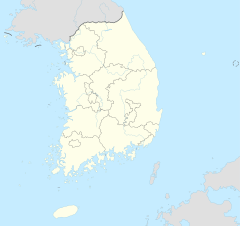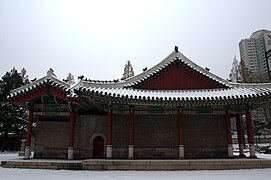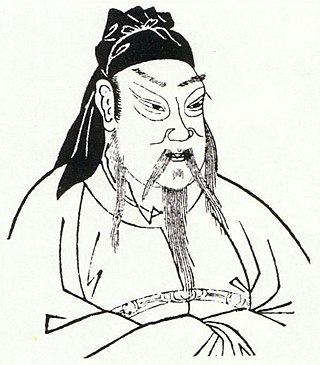
Guan Yu, courtesy name Yunchang, was a Chinese military general serving under the warlord Liu Bei during the late Eastern Han dynasty of China. Along with Zhang Fei, he shared a brotherly relationship with Liu Bei and accompanied him on most of his early exploits. Guan Yu played a significant role in the events leading up to the end of the Han dynasty and the establishment of Liu Bei's state of Shu Han during the Three Kingdoms period. While he is remembered for his loyalty towards Liu Bei, he is also known for repaying Cao Cao's kindness by slaying Yan Liang, a general under Cao Cao's rival Yuan Shao, at the Battle of Boma. After Liu Bei gained control of Yi Province in 214, Guan Yu remained in Jing Province to govern and defend the area for about seven years. In 219, while he was away fighting Cao Cao's forces at the Battle of Fancheng, Liu Bei's ally Sun Quan broke the Sun–Liu alliance and sent his general Lü Meng to conquer Liu Bei's territories in Jing Province. By the time Guan Yu learned about the loss of Jing Province after his defeat at Fancheng, it was too late. He was subsequently captured in an ambush by Sun Quan's forces and executed at Linju, Xiangyang Commandery.
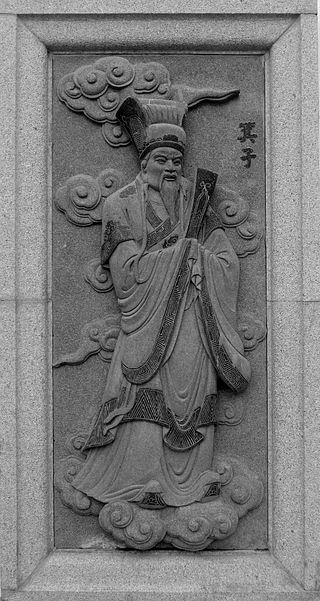
Jizi, Qizi, or Kizi was a semi-legendary Chinese sage who is said to have ruled Gija Joseon in the 11th century BCE. Early Chinese documents like the Book of Documents and the Bamboo Annals described him as a virtuous relative of the last king of the Shang dynasty who was punished for remonstrating with the king. After Shang was overthrown by Zhou in the 1040s BCE, he allegedly gave political advice to King Wu, the first Zhou king. Chinese texts from the Han dynasty onwards claimed that King Wu enfeoffed Jizi as ruler of Chaoxian. According to the Book of Han, Jizi brought agriculture, sericulture, and many other facets of Chinese civilization to Joseon. His family name was Zi/Ja (子) and given name was Xuyu/Suyu.

Yasukuni Shrine is a Shinto shrine located in Chiyoda, Tokyo. It was founded by Emperor Meiji in June 1869 and commemorates those who died in service of Japan, from the Boshin War of 1868–1869, to the two Sino-Japanese Wars, 1894–1895 and 1937–1945 respectively, and the First Indochina War of 1946–1954, including war criminals. The shrine's purpose has been expanded over the years to include those who died in the wars involving Japan spanning from the entire Meiji and Taishō periods, and the earlier part of the Shōwa period.

Wokou, which translates to "Japanese pirates", were pirates who raided the coastlines of China and Korea from the 13th century to the 17th century. The wokou were made of various ethnicities of East Asian ancestry, which varied over time and raided the mainland from islands in the Sea of Japan and East China Sea. Wokou activity in Korea declined after the Treaty of Gyehae in 1443 but continued in Ming China and peaked during the Jiajing wokou raids in the mid-16th century. Chinese reprisals and strong clamp-downs on pirates by Japanese authorities saw the wokou disappear by the 17th century.

In the Battle of Myeongnyang, on October 26, 1597, the Korean Joseon Kingdom's navy, led by Admiral Yi Sun-sin, fought the Japanese navy in the Myeongnyang Strait, near Jindo Island, off the southwest corner of the Korean Peninsula.

Jongmyo (Korean: 종묘) is a Confucian royal ancestral shrine in the Jongno District of Seoul, South Korea. It was originally built during the Joseon period (1392–1897) for memorial services for deceased kings and queens. According to UNESCO, the shrine is the oldest royal Confucian shrine preserved and the ritual ceremonies continue a tradition established in the 14th century. Such shrines existed during the Three Kingdoms of Korea period (57–668), but these have not survived. The Jongmyo Shrine was added to the UNESCO World Heritage list in 1995.

Hokuzan, also known as Sanhoku (山北) before the 18th century, located in the north of Okinawa Island, was one of three independent political entities which controlled Okinawa in the 14th century during Sanzan period. The political entity was identified as a tiny country, a kingdom, or a principality by modern historians, however the ruler of Hokuzan was in fact not "kings" at all, but petty lords with their own retainers owing their direct service, and their own estates.

Dongmyo Station is a station on the Seoul Subway Line 1 and Line 6. It is named after a nearby shrine, built during the Joseon dynasty to honor Guan Yu, arguably the most famous Chinese military general from the Three Kingdoms era.
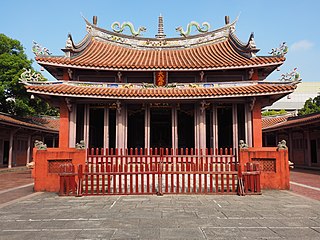
The Tainan Confucian Temple or Quan Tai Shou Xue, is a Confucian temple on Nanmen Road (南門路) in West Central District, Tainan, Taiwan.

The Imperial Ancestral Temple, or Taimiao of Beijing, is a historic site in the Imperial City, just outside the Forbidden City, where during both the Ming and Qing dynasties, sacrificial ceremonies were held on the most important festival occasions in honor of the imperial family's ancestors.

Chōsen Shrine was the most important Shinto shrine during the Japanese colonial period in Korea. It was built in 1925 in Seoul and destroyed soon after the end of colonial rule in 1945.

State Temple of the Martial God, also called Tainan Sacrificial Rites Martial Temple or Grand Guandi Temple, is a temple located in Yongfu Road, West Central District, Tainan, Taiwan. This temple was previously the palace of Koxinga and Prince of Ningjing, members of the Ming imperial family who retreated to Taiwan in the dying days of the Ming dynasty.
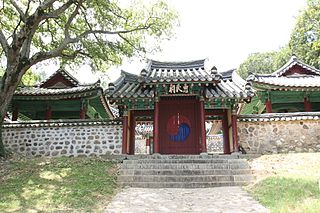
Located in Gogeum-myeon, Wando County, South Jeolla Province, South Korea, Chungmusa is a shrine built to remember the noble patriotic spirit of Admiral Yi Sun-sin. Chungmusa on Gogeum continues to hold a memorial service every year on April 28, the admiral’s birthday, and mark his patriotic fall on November 19.

The Second Shō dynasty was the last dynasty of the Ryukyu Kingdom from 1469 to 1879, ruled by the Second Shō family under the title of King of Chūzan. This family took the family name from the earlier rulers of the kingdom, the first Shō family, even though the new royal family has no blood relation to the previous one. Until the abolition of Japanese peerage in 1947, the head of the family was given the rank of marquess while several cadet branches held the title of baron.
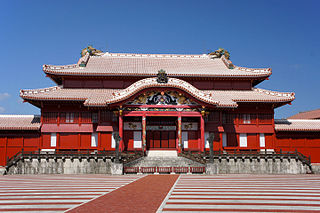
The First Shō dynasty was a dynasty of the Ryukyu Kingdom on Okinawa Island in the 15th century, ruled by the First Shō family under the title of King of Chūzan. According to the official history books compiled during the second Shō Dynasty, it lasted from 1406 to 1469. However, the official account is considered unreliable by modern historians because it contradicts contemporary sources.

Lingguang Temple is a Buddhist temple located on the east hillside of Mount Cuiwei (翠微山), in the Shijingshan District of Beijing. The temple is renowned for its collection of the tooth relic of the Buddha.

Chenxiang Pavilion or Chenxiangge Nunnery is a Buddhist temple located in the Huangpu District of Shanghai. It is currently serving as a nunnery for Buddhist nuns.

Guan Yu Shrine or written as Gong Wu Shrine is a historic shrine of Lord Guan, Martial God of Loyalty and Righteousness in Chinese beliefs. Located in Khwaeng Somdet Chao Phraya, Khet Khlong San, Bangkok's Thonburi side on the western bank of Chao Phraya River.
The Huáyí yìyǔ refers to a series of vocabularies produced by Ming and Qing dynasty Chinese administration for the study of foreign languages. They are a precious source of phonological information, both for the study of Chinese pronunciation and for the study of the languages in question.
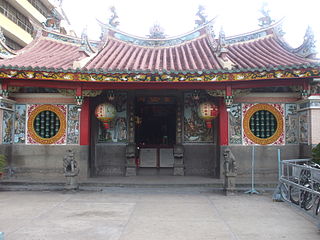
Miao (廟/庙) are buildings in traditional East Asian religions enshrining gods, myths or legends, sages of past dynasties, and famous historical figures. They are a kind of Chinese temple architecture and contrast with Ci shrines which enshrine ancestors and people instead of deities.


